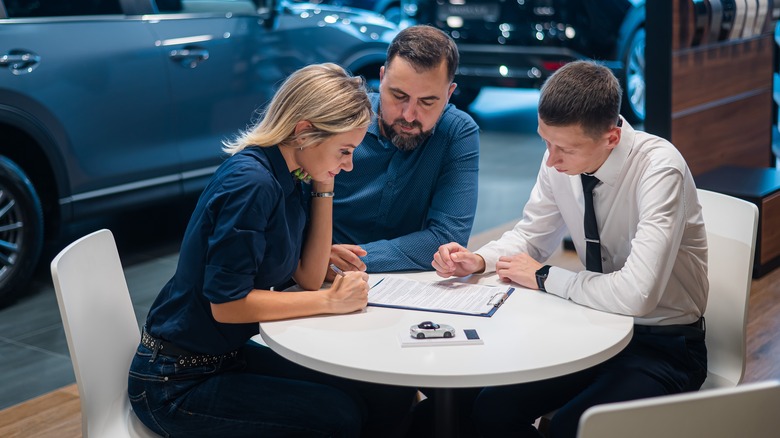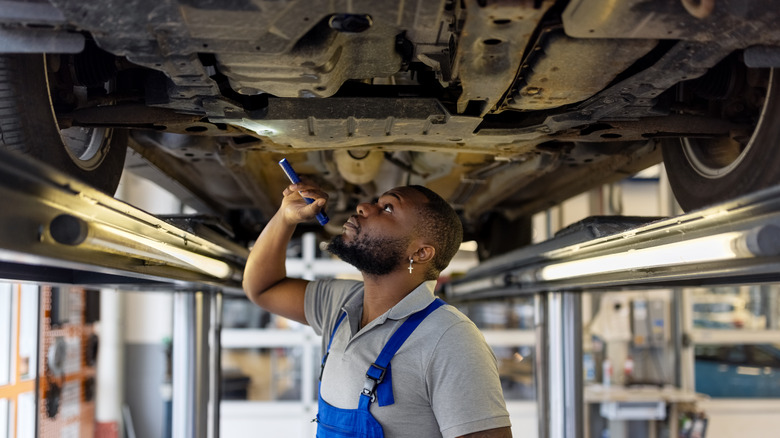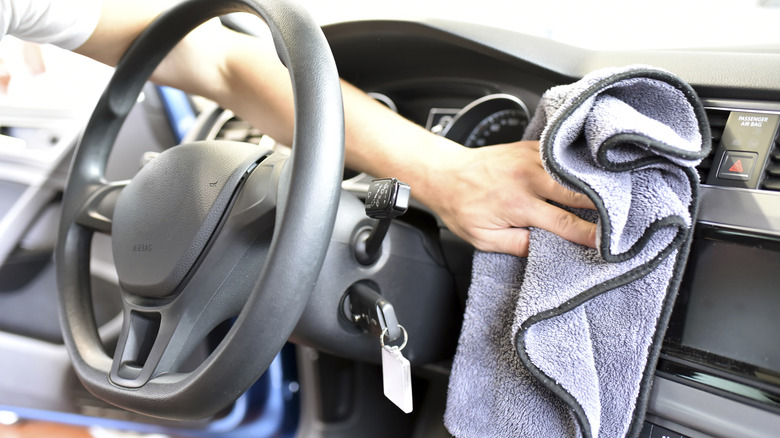4 Ways To Get More For Your Vehicle Trade-In
Many people choose to trade in their vehicle versus selling it themselves, usually due to one main reason — convenience. It makes sense, as it can be exhausting to reply to inquiries, set showing times, and then hope that the potential buyers aren't just wasting your time. Not to mention, not only can buyers on Facebook marketplace get scammed, but so can the sellers — which can be a nightmare when dealing with an item that costs thousands of dollars like a vehicle.
However, just like how there are things you should look out for when buying a used car or important questions to ask when buying a new car, trading in a vehicle isn't as straightforward as it may seem. Like any business, dealerships need to make a profit, so they will do anything they can to get your trade-in vehicle as cheap as possible. In order to protect yourself and get the most money, it is important to be prepared. With over five years of experience in automotive sales, I'm going to give you tips on how to get more for your trade-in vehicle. Let's get started.
Do research on your vehicle's value beforehand
Before going to a dealership, it is vital to get an idea as to what your vehicle's trade-in value is. Kelly Blue Book and J.D. Power are both excellent tools to use. Simply enter your vehicle year, make, model, trim, and current mileage, and both sites will give you three trade-in-to-dealer values: rough, average, and clean.
To better understand these values, rough condition means the car has mechanical or electrical problems, interior or exterior damage, a rebuilt title, or other issues that will require a substantial investment to get ready for resale. Average condition is where many vehicles find themselves with having normal wear and tear, the vehicle is mechanically sound, and has a clean title history. Clean condition vehicles are usually garage kept with no mechanical issues, minimal wear to the interior and exterior, and require minimal reconditioning to get ready for the car lot.
When looking at these car value estimates, it's very important to be honest with yourself about the current condition of your vehicle. Have you kept up with your car's maintenance schedule? Has it been in an accident, or has exterior damage? Has it been smoked in? Does it need new tires or any significant repairs? These are just some of the questions you need to ask yourself when getting an idea as to what your car is worth. If your vehicle is sitting in the rough to below average condition value right now, there are some things you can do to change that.
Address mechanical problems
While you may not always know what exactly is wrong with your car, it's pretty easy to know when there is a problem. Usually, the biggest giveaway is a check engine light — which could be on for several reasons. If this is the case, then owning a diagnostics tool can save you a ton of money as you can get a firm understanding of what the issue is. However, there are other ways to check engine codes without a scanner, such as going to your local auto parts store and borrowing one. Since a check engine light is a big red flag to a dealer, it is important to address the issues — that are within your means — to boost the value.
This is also a good time to check if your vehicle has any recalls by using the NHTSA free tool. If your vehicle does have a recall, then make an appointment with your local dealer, and they will fix it free of charge. Then, round up any maintenance or repair receipts that you have to show to the dealer during the negotiations, if necessary. Even if you don't decide to trade in your vehicle, these receipts should be kept and filed for the future.
Detail your vehicle
When car shopping, it may be a turn-off when the vehicle is covered in mud, has stains or dog hair in the interior, or smells like a soiled diaper, right? Well, the same goes for a dealer when they do an appraisal on your trade-in. That's why it is important to detail your car, whether you do it yourself or go to a professional.
Most of the detailing tools may already be in your garage, such as a shop vac, pressure sprayer, and interior cleaners. If not, Walmart and local auto parts stores will have supplies that won't cost too much compared to a professional detail, which can range from $150 to $500 or more. Give the interior a thorough cleaning and, if need be, head to a quality car wash right before going to the dealer.
If you or the previous owner smoked in the vehicle and the smell is apparent, it is worth using an ozone machine from a detail shop or finding other products to mask the smell. Smoke smell can put a big dent in your car's value, so it is important to address that. After detailing your vehicle, only return items that are absolutely necessary, as the less junk you have in your car, the easier it is to show how clean it is.
Time your trade-in and negotiate
Depending on how soon you want to buy a new vehicle, it is wise to time your trade-in. The type of vehicle you own and the seasonal weather in your area can affect the value. For example, an all-wheel drive SUV will be more valuable on a dealer lot during the wintertime due to buyer demand. In contrast, a dealer may also be more enticed to give more for a rear-wheel drive sports car during the summer months. This may not be the case for everyone, but it is something to keep in mind.
Now for the fun part: negotiations. Remember, dealers are going to try to lowball you, no matter how clean it is or what recent work has been done — it's just the name of the game. However, this is the time to showcase your knowledge of the market values and present maintenance and repair receipts. Be firm with what you want for your vehicle to make a deal, but again, be realistic. You won't get what a Corvette is worth on a Pontiac Aztek, even if it was ahead of its time, I hate to tell you.
If push comes to shove and the dealer won't budge, then don't be afraid to walk away. If you were being fair with what you were asking for in trade-in value, nine times out 10, the salesperson will call you back with a better offer. In the meantime, it is worth going to other dealerships to see what they will give you on trade if they also have a vehicle you are interested in. Who knows, you might be able to use the other offers as leverage for negotiations and get a better deal.




